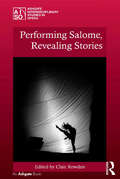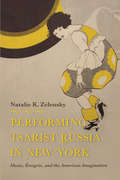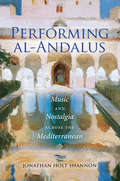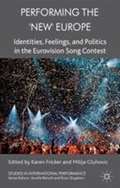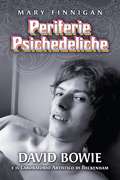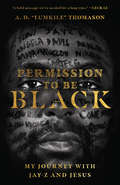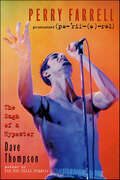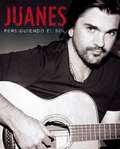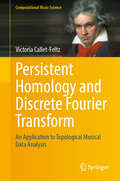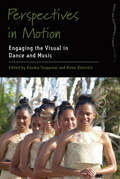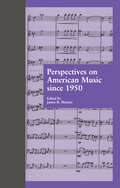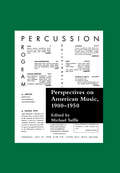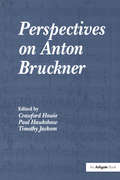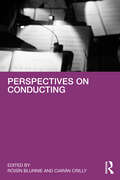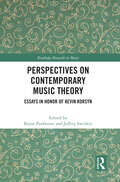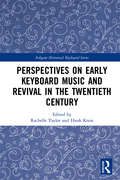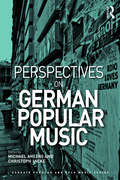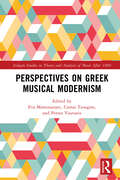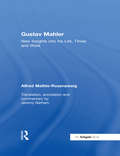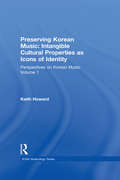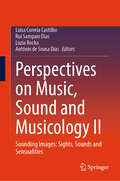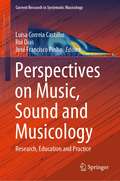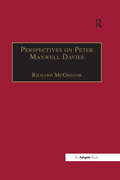- Table View
- List View
Performing Salome, Revealing Stories (Ashgate Interdisciplinary Studies in Opera)
by Clair RowdenWith its first public live performance in Paris on 11 February 1896, Oscar Wilde's Salomé took on female embodied form that signalled the start of 'her' phenomenal journey through the history of the arts in the twentieth century. This volume explores Salome's appropriation and reincarnation across the arts - not just Wilde's heroine, nor Richard Strauss's - but Salome as a cultural icon in fin-de-siècle society, whose appeal for ever new interpretations of the biblical story still endures today. Using Salome as a common starting point, each chapter suggests new ways in which performing bodies reveal alternative stories, narratives and perspectives and offer a range and breadth of source material and theoretical approaches. The first chapter draws on the field of comparative literature to investigate the inter-artistic interpretations of Salome in a period that straddles the end of the nineteenth century and the beginning of the Modernist era. This chapter sets the tone for the rest of the volume, which develops specific case studies dealing with censorship, reception, authorial reputation, appropriation, embodiment and performance. As well as the Viennese premiere of Wilde's play, embodied performances of Salome from the period before the First World War are considered, offering insight into the role and agency of performers in the production and complex negotiation of meaning inherent in the role of Salome. By examining important productions of Strauss's Salome since 1945, and more recent film interpretations of Wilde's play, the last chapters explore performance as a cultural practice that reinscribes and continuously reinvents the ideas, icons, symbols and gestures that shape both the performance itself, its reception and its cultural meaning.
Performing Tsarist Russia in New York: Music, Émigrés, and the American Imagination (Russian Music Studies)
by Natalie K. ZelenskyAn examination of the popular music culture of the post-Bolshevik Russian emigration and the impact made by this group on American culture and politics.Performing Tsarist Russia in New York begins with a rich account of the musical evenings that took place in the Russian émigré enclave of Harlem in the 1920s and weaves through the world of Manhattan’s Russian restaurants, Tin Pan Alley industry, Broadway productions, 1939 World’s Fair, Soviet music distributors, postwar Russian parish musical life, and Cold War radio programming to close with today’s Russian ball scene, exploring how the idea of Russia Abroad has taken shape through various spheres of music production in New York over the course of a century. Engaging in an analysis of musical styles, performance practice, sheet music cover art, the discourses surrounding this music, and the sonic, somatic, and social realms of dance, author Natalie K. Zelensky demonstrates the central role played by music in shaping and maintaining the Russian émigré diaspora over multiple generations as well as the fundamental paradox underlying this process: that music’s sustaining power in this case rests on its proclivity to foster collective narratives of an idealized prerevolutionary Russia while often evolving stylistically to remain relevant to its makers, listeners, and dancers. By combining archival research with fieldwork and interviews with Russian émigrés of various generations and emigration waves, Zelensky presents a close historical and ethnographic examination of music’s potential as an aesthetic, discursive, and social space through which diasporans can engage with an idea of a mythologized homeland, and, in turn, the vital role played by music in the organization, development, and reception of Russia Abroad.
Performing Tsarist Russia in New York: Music, Émigrés, and the American Imagination (Russian Music Studies)
by Natalie K. ZelenskyAn examination of the popular music culture of the post-Bolshevik Russian emigration and the impact made by this group on American culture and politics.Performing Tsarist Russia in New York begins with a rich account of the musical evenings that took place in the Russian émigré enclave of Harlem in the 1920s and weaves through the world of Manhattan’s Russian restaurants, Tin Pan Alley industry, Broadway productions, 1939 World’s Fair, Soviet music distributors, postwar Russian parish musical life, and Cold War radio programming to close with today’s Russian ball scene, exploring how the idea of Russia Abroad has taken shape through various spheres of music production in New York over the course of a century. Engaging in an analysis of musical styles, performance practice, sheet music cover art, the discourses surrounding this music, and the sonic, somatic, and social realms of dance, author Natalie K. Zelensky demonstrates the central role played by music in shaping and maintaining the Russian émigré diaspora over multiple generations as well as the fundamental paradox underlying this process: that music’s sustaining power in this case rests on its proclivity to foster collective narratives of an idealized prerevolutionary Russia while often evolving stylistically to remain relevant to its makers, listeners, and dancers. By combining archival research with fieldwork and interviews with Russian émigrés of various generations and emigration waves, Zelensky presents a close historical and ethnographic examination of music’s potential as an aesthetic, discursive, and social space through which diasporans can engage with an idea of a mythologized homeland, and, in turn, the vital role played by music in the organization, development, and reception of Russia Abroad.
Performing al-Andalus
by Jonathan Holt ShannonPerforming al-Andalus explores three musical cultures that claim a connection to the music of medieval Iberia, the Islamic kingdom of al-Andalus, known for its complex mix of Arab, North African, Christian, and Jewish influences. Jonathan Holt Shannon shows that the idea of a shared Andalusian heritage animates performers and aficionados in modern-day Syria, Morocco, and Spain, but with varying and sometimes contradictory meanings in different social and political contexts. As he traces the movements of musicians, songs, histories, and memories circulating around the Mediterranean, he argues that attention to such flows offers new insights into the complexities of culture and the nuances of selfhood.
Performing the 'New' Europe
by Milija Gluhovic Karen FrickerThis fascinating and lively volume makes the case that the Eurovision Song Contest is an arena for European identification in which both national solidarity and participation in a European identity are confirmed, and a site where cultural struggles over the meanings, frontiers and limits of Europe are enacted.
Periferie Psichedeliche
by Andrea Giampaoli Mary FinniganDavid Bowie ha ispirato decine di biografie sul suo genio musicale, ma nessuna mai così ricca di particolari - e di foto inedite - come quella degli esordi dell’artista nella periferia londinese raccontanti dalla giornalista Mary Finnigan in Psychedelic Suburbia – David Bowie and The Beckenham Arts Lab, pubblicato da Jorvik Press . É la storia di un giovanissimo Bowie, ancora sconosciuto, in cerca di ingaggi per concerti nei club di Londra. Mary Finnigan racconta di averlo accolto nella sua casa nel quartiere londinese di Beckenham, sostenendolo economicamente e di esserne divenuta la sua amante. Insieme fondarono un folk club al pub Three Tuns di Beckenham, organizzando riunioni settimanali alle quali man mano partecipavano sempre più persone tra poeti, studenti di cinema e altri creativi. Il club divenne un vero e proprio laboratorio artistico, The Beckenham Arts Lab, tra arti visive, teatro, poesia e musica, una Factory proprio come quella che stava creando Andy Warhol a New York. Il tutto culminerà nel Free Festival del 1696, evento che Bowie canterà nella famosa canzone "Memory of a Free Festival". Traduzione a cura di Andrea Giampaoli
Permission to Be Black: My Journey with Jay-Z and Jesus
by A. D. ThomasonEmbracing your Christian identity does not make you "soft." Embracing your Black identity does not make you less Christian. Throughout American history, Black people were not given the freedom to acknowledge their suffering. A. D. Thomason believes that the Holy Spirit brings freedom and liberation as we're able to name our pain, recognize its roots in history and society, and seek healing. While many saw a confident, six-foot-five Black man, A. D. "Lumkile" Thomason lived most of his life in fear and anguish, deeply wounded by encounters with violence, abandonment, and family tragedy. Hiding behind a tough exterior, Adam earned his "Black card" but felt joyless inside. Even traveling around the globe to play professional basketball could not resolve his despair. But in the art of Jay-Z, A. D. discovered stirring honesty that gave voice to his own expressions of longing. And in the gospel of Jesus, he experienced the healing and salvation that had long evaded him. Now through what he calls "kingdom therapy," he's figuring out how to redefine the Jay-Z and Jesus that make up his blackness. A. D. uses his artistry as a poet and storyteller to share how he confessed his internalized pain and embraced the liberating joy of Christ. He writes for millennials, emerging adults, and anyone else who's ready to acknowledge the reality of racial trauma and our need to confront it. A. D.'s powerful story gives you permission to be Black, to be Christian, and to be the person God has made you to be.
Perry Farrell: The Saga of a Hypester
by Dave ThompsonDave Thompson's biography of Perry Farrell traces the performer's life from his childhood in Flushing, Queens to becoming front man for the band Jane's Addiction to his founding of the touring festival, Lollapalooza. Perry Farrell: The Saga of a Hypester sheds light on a man who remains a mystery to all but a few.
Persiguiendo el sol
by Juanes"Yo, por mi lado, cumplo con hacer lo que creo que he venido a hacer al mundo: tocar y componer música buscando con ello despertar conciencias, renovar corazones y generar un cambio. Seguiré mirando las estrellas y viajando por el mundo hasta que Dios me lo permita. Ojalá pueda seguir por muchos años más conectando vidas a través del arte, tocando mi guitarra y persiguiendo el sol". --Juanes En Persiguiendo el sol el ícono humanitario y estrella internacional de la música comparte la increíble historia de su vida y de cómo la música y la fe lo han guiado en su camino. En sus propias palabras y con deslumbrantes fotografías --algunas nunca antes vistas-- Juanes habla de sus momentos más definitivos, desde su infancia hasta el presente, reflexionando acerca de su camino espiritual y musical y sobre las experiencias personales y profesionales que lo han convertido en el hombre que es hoy. Juanes nació y se crió en Colombia. De su familia heredó un gran amor por la música y aprendió a tocar la guitarra desde pequeño. A los dieciséis años se convirtió en miembro fundador, cantante, guitarrista y compositor de Ekhymosis, que llegó a ser uno de los grupos de rock más famosos de Colombia. Sin embargo, fue su carrera como solista la que lo propulsó al estrellato internacional. Con gran honestidad, Juanes cuenta cómo sus momentos de gloria estuvieron muchas veces plagados de incertidumbre e introspección, y cómo el hecho de mantenerse fiel a sus creencias y apasionado por su arte le dio la fuerza y la visión para reinventarse. Mientras que su vida como artista ha sido ampliamente documentada, el Juanes más privado jamás se ha revelado en sus propias palabras... hasta ahora.
Persistent Homology and Discrete Fourier Transform: An Application to Topological Musical Data Analysis (Computational Music Science)
by Victoria Callet-FeltzThis book proposes contributions to various problems in the field of topological analysis of musical data: the objects studied are scores represented symbolically by MIDI files, and the tools used are the discrete Fourier transform and persistent homology. The manuscript is divided into three parts: the first two are devoted to the study of the aforementioned mathematical objects and the implementation of the model. More precisely, the notion of DFT introduced by Lewin is generalized to the case of dimension two, by making explicit the passage of a musical bar from a piece to a subset of Z/tZ×Z/pZ, which leads naturally to a notion of metric on the set of musical bars by their Fourier coefficients. This construction gives rise to a point cloud, to which the filtered Vietoris-Rips complex is associated, and consequently a family of barcodes given by persistent homology. This approach also makes it possible to generalize classical results such as Lewin's lemma and Babitt's Hexachord theorem. The last part of this book is devoted to musical applications of the model: the first experiment consists in extracting barcodes from artificially constructed scores, such as scales or chords. This study leads naturally to song harmonization process, which reduces a song to its melody and chord grid, thus defining the notions of graph and complexity of a piece. Persistent homology also lends itself to the problem of automatic classification of musical style, which will be treated here under the prism of symbolic descriptors given by statistics calculated directly on barcodes. Finally, the last application proposes a encoding of musical bars based on the Hausdorff distance, which leads to the study of musical textures. The book is addressed to graduate students and researchers in mathematical music theory and music information research, but also at researchers in other fields, such as applied mathematicians and topologists, who want to learn more about mathematical music theory or music information research.
Perspectives in Motion: Engaging the Visual in Dance and Music (Dance and Performance Studies #15)
by Kendra Stepputat Brian DiettrichFocusing on visual approaches to performance in global cultural contexts, Perspectives in Motion explores the work of Adrienne L. Kaeppler, a pioneering researcher who has made a number of interdisciplinary contributions over five decades to dance and performance studies. Through a diverse range of case studies from Oceania, Asia, and Europe, and interdisciplinary approaches, this edited collection offers new critical and ethnographic frameworks for understanding and experiencing practices of music and dance across the globe.
Perspectives in Motion: Engaging the Visual in Dance and Music (Dance and Performance Studies #15)
by Kendra Stepputat Brian DiettrichFocusing on visual approaches to performance in global cultural contexts, Perspectives in Motion explores the work of Adrienne L. Kaeppler, a pioneering researcher who has made a number of interdisciplinary contributions over five decades to dance and performance studies. Through a diverse range of case studies from Oceania, Asia, and Europe, and interdisciplinary approaches, this edited collection offers new critical and ethnographic frameworks for understanding and experiencing practices of music and dance across the globe.
Perspectives on American Music since 1950 (Essays in American Music)
by James R. HeintzeAs the century comes to a close, composition of music in the United States has reached little consensus in terms of style, techniques, or schools. In fourteen original articles, the contributors to this volume explore the broad range and diversity of post-World War II musical culture. Classical and jazz idioms are both covered, as is the broad history of electronic music in the United States.
Perspectives on American Music, 1900-1950 (Essays in American Music #3)
by Michael SaffleThe essays in this collection reflect the range and depth of musical life in the United States during the first half of the twentieth century. Contributions consider the rise and triumph of popular forms such as jazz, swing, and blues, as well as the contributions to art music of composers such as Ives, Cage, and Copland, among others. American contributions to music technology and dissemination, and the role of these forms in extending the audience for music, is also a focus.
Perspectives on Anton Bruckner
by Timothy Jackson Crawford Howie Paul HawkshawA century after his death Anton Bruckner still remains one of the most complex and enigmatic creative personalities of the nineteenth century. A leading avant-garde figure of his generation, he was an accomplished performer and teacher in addition to being a great composer; few people in the history of western music can boast his level of achievement in all these areas combined. This book, a collection of essays written by an international group of scholars, offers diverse theoretical and musicological perspectives on Bruckner the composer-teacher-performer. Facets of his formidable theoretical training and his application of it as part of the compositional process are explored. A variety of analytical methodologies is used to examine the Second through to the Ninth Symphonies, the heart of the composer‘s mature repertoire. Finally, aspects of Bruckner‘s career as a teacher and performer, his complex personality, his influence and dissemination of his music are considered.
Perspectives on Conducting
by Róisín Blunnie Ciarán CrillyRooted in research and practice, Perspectives on Conducting presents a multi-faceted exploration of the role of the modern-day conductor. Seeking to bring a more inclusive approach to understanding conducting as a career, this book expands beyond elite pathways to highlight the contributions made by conductors across different areas of musical engagement, including youth projects, community groups, and professional ensembles. Chapters by an international roster of authors address the challenges conductors face in working with a wide range of ensembles, including orchestras and choirs made up of young people, university and conservatory students, adult volunteers, and professional musicians.The contributors draw on their experience and expertise as practising conductors and scholar-practitioners to explore both the core musical responsibilities and the additional administrative and social demands placed on today’s conductors. With topics including pathways to conducting careers, the creative role of the conductor in shaping new music, conducting mixed-ability ensembles, the experiences of women and queer conductors, and more, the perspectives collected here reflect the versatility required of the contemporary conductor, giving students and emerging professionals a forward-thinking view of the conductor’s role.
Perspectives on Contemporary Music Theory: Essays in Honor of Kevin Korsyn (Routledge Research in Music)
by Jeffrey Swinkin Bryan ParkhurstKevin Korsyn is a renowned music theorist, musicologist, and pedagogue who has taught at the University of Michigan since 1992. He has published widely and influentially in areas as diverse as Beethoven and Brahms studies, chromatic tonality, disciplinarity and metatheory, history of theory, musical meaning and hermeneutics, poststructuralism (deconstruction, intertextuality, etc.), and Schenkerian theory and analysis. Because of the scope and caliber of his published work, and also his legacy as a pedagogue, Korsyn has had a profound impact on the field of music theory, along with the related fields of historical musicology and aesthetics. This book, a festschrift for Korsyn, comprises essays that constellate around his numerous scholarly foci. Represented in the volume are not only familiar music-theoretical topics such as chromaticism, form, Schenker, and text-music relations, but also various interdisciplinary topics such as deconstruction, disability studies, German Idealism, posthumanism, and psychoanalysis. The book thus reflects the increasingly multifaceted intellectual landscape of contemporary music theory.
Perspectives on Early Keyboard Music and Revival in the Twentieth Century (Ashgate Historical Keyboard Series)
by Rachelle Taylor Hank KnoxThe twentieth-century revival of early music unfolded in two successive movements rooted respectively in nineteenth-century antiquarianism and in rediscovery of the value of original instruments. The present volume is a collection of insights reflecting the principal concerns of the second of those revivals, focusing on early keyboards, and beginning in the 1950s. The volume and its authors acknowledge Canadian harpsichordist Kenneth Gilbert (b. 1931) as one of this revival’s leaders. The content reflects international research on early keyboard music, sources, instruments, theory, editing, and discography. Considerations that echo throughout the book are the problematics of source attributions, progressive institutionalization of early music, historical instruments as agents of artistic change and education, antecedents and networks of the revival seen as a social phenomenon, the impact of historical performance and the quest for understanding style and genre. The chapters cover historical performance practice, source studies, edition, theory and form, and instrument curating and building. Among their authors are prominent figures in performance, music history, editing, instrument building and restoration, and theory, some of whom engaged with the early keyboard revival as it was happening.
Perspectives on German Popular Music (Ashgate Popular and Folk Music Series)
by Michael Ahlers Christoph JackeIn this book, native popular musicologists focus on their own popular music cultures from Germany, Austria and Switzerland for the first time: from subcultural to mainstream phenomena; from the 1950s to contemporary acts. Starting with an introduction and two chapters on the histories of German popular music and its study, the volume then concentrates on focused, detailed and yet concise close readings from different perspectives (including particular historical East and West German perspectives), mostly focusing on the music and its protagonists. Moreover, these analyses deal with very original specific genres such as Schlager and Krautrock as well as transcultural genres such as Punk or Hip Hop. There are additional chapters on characteristically German developments within music media, journalism and the music industry. The book will contribute to a better understanding of German, Austrian and Swiss popular music, and will interconnect international and especially Anglo-American studies with German approaches. The book, as a consequence, will show close connections between global and local popular music cultures and diverse traditions of study.
Perspectives on Greek Musical Modernism (Ashgate Studies in Theory and Analysis of Music After 1900)
by Eva Mantzourani Costas Tsougras Petros VouvarisThis is the first book to investigate systematically the diverse aspects and compositional approaches of Greek musical modernism.The volume contributes to ongoing discussions about aesthetic modernism in general and the epistemological issues that pertain to its historiography, especially with respect to challenging the centre–periphery dichotomy that has previously informed its conceptual framework. The book strikes a balance between offering thematically focused contributions and serving as a reference source for scholars interested in looking more thoroughly into unexamined or overlooked aspects of musical modernism. To do so, it encompasses a variety of case studies, presented in a series of 13 chapters that cover a wide array of methodological approaches, from historical and critical to analytical and philosophical. These chapters are organised along the lines of a historical narrative that traces the reception of musical modernism in Greece, ranging from downright rejection during the mid-war period to affirmative institutionalisation in the post-war years.In this context, the book will interest not only musicians, musicologists, and music theorists but also cultural historians and other scholars involved in studying the emergence, development, and dissemination of modernism worldwide.
Perspectives on Gustav Mahler
by Jeremy BarhamGustav Mahler's music continues to enjoy global prominence, both in live or recorded performance and within broader ranges of critical perception and cultural sensibility. In recognition of such a profile, this volume brings together a unique collection of essays exploring the diverse methods and topics characteristic of recent advances in Mahler scholarship. The book's international group of contributors is actively involved not only in bringing fresh approaches to Mahler research in areas such as analysis, sketch studies and reception history, but also in examining hitherto neglected issues of cultural and biographical interpretation, performance practice and compositional aesthetic, thereby illustrating the developing vitality and scope of this field. Engaging with its subject from reconstructive, documentary, theoretical, analytical, discursive and interpretative viewpoints, this volume provides a wide spectrum of contexts in which continuing debate about Mahler's life and works can flourish. Its varied themes and strategies nevertheless collectively recognize and negotiate the shifting space both between the composer's life and his artistic creativity, and between the musical results of that creativity and the critical-analytical process. The essays in this book accordingly fill certain gaps in the scholarly understanding of the composer, and re-orientate Mahler studies towards some of the central concerns of contemporary musicological thinking.
Perspectives on Korean Music: Volume 1: Preserving Korean Music: Intangible Cultural Properties as Icons of Identity (SOAS Studies in Music)
by Keith HowardAs Korea has developed and modernized, music has come to play a central role as a symbol of national identity. Nationalism has been stage managed by scholars, journalists and, from the beginning of the 1960s, by the state, as music genres have been documented, preserved and promoted as 'Intangible Cultural Properties'. Practitioners have been appointed 'holders' or, in everyday speech, 'Human Cultural Properties', to maintain, perform and teach exemplary versions of tradition. Over the last few years, the Korean preservation system has become a model for UNESCO's 'Living Human Treasures' and 'Masterpieces of the Oral and Intangible Heritage of Mankind'. In this volume, Keith Howard provides the first comprehensive analysis in English of the system. He documents court music and dance, Confucian and shaman ritual music, folksongs, the professional folk-art genres of p'ansori ('epic storytelling through song') and sanjo ('scattered melodies'), and more, as well as instrument making, food preparation and liquor distilling - a good performance, after all, requires wine to flow. The extensive documentation reflects considerable fieldwork, discussion and questioning carried out over a 25-year period, and blends the voices of scholars, government officials, performers, craftsmen and the general public. By interrogating both contemporary and historical data, Howard negotiates the debates and critiques that surround this remarkable attempt to protect local and national music and other performance arts and crafts. An accompanying CD illustrates many of the music genres considered, featuring many master musicians including some who have now died. The preservation of music and other performance arts and crafts is part of the contemporary zeitgeist, yet occupies contested territory. This is particularly true when the concept of 'tradition' is invoked. Within Korea, the recognition of the fragility of indigenous music inherited from earlier times is balanced by an awareness of the need to maintain identity as lifestyles change in response to modernization and globalization. Howard argues that Korea, and the world, is a better place when the richness of indigenous music is preserved and promoted.
Perspectives on Music, Sound and Musicology II: Sounding Images: Sights, Sounds and Sensualities
by Luísa Correia Castilho Rui Sampaio Dias Luzia Rocha António de Sousa DiasThis book gathers a set of peer-reviewed works at the intersection between music, sound, and image research and practice. They are based on presentations contributed to the EIMAD–Meeting of Research in Music, Arts and Design conference, held at the Polytechnic University of Castelo Branco, Portugal, in 2020 and 2022, under the theme: "Sounding Images”. Authored by researchers in musicology, musical iconography, cinema and audiovisuals, digital arts, composition, sound art, and data sonification, the 21 chapters of this book offer a valuable resource and source of inspiration for professionals, researchers and general audiences in these interconnected fields.
Perspectives on Music, Sound and Musicology: Research, Education and Practice (Current Research in Systematic Musicology #10)
by Luísa Correia Castilho Rui Dias José Francisco PinhoThis book gathers a set of works highlighting significant advances in the areas of music and sound. They report on innovative music technologies, acoustics, findings in musicology, new perspectives and techniques for composition, sound design and sound synthesis, and methods for music education and therapy. Further, they cover interesting topics at the intersection between music and computing, design and social sciences. Chapters are based on extended and revised versions of the best papers presented during the 6th and 7th editions of EIMAD–Meeting of Research in Music, Arts and Design, held in 2020 and 2021, respectively, at the School of Applied Arts in Castelo Branco, Portugal. All in all, this book provides music researchers, educators and professionals with authoritative information about new trends and techniques, and a source of inspiration for future research, practical developments, and for establishing collaboration between experts from different fields.
Perspectives on Peter Maxwell Davies
by Richard McGregor"As a composer one forgets, in time, the fine detail of composition processes which produced past work... it must be left to scholars to recreate, slowly and painstakingly, earlier creative processes." Peter Maxwell Davies. In the eight essays presented here, leading scholars of the music of Peter Maxwell Davies explore some of the composer's creative processes. David Roberts, Peter Owens and Richard McGregor examine Davies's employment of pitch-class sets and other models evident in his sketch material, while Joel Lester looks at the serial elements that produce structure and effect in the work Ave Maris Stella. The political, literary and musical influences evident in the 1987 opera Resurrection and in subsequent orchestral works come under scrutiny from John Warnaby. Davies's use of older dramatic forms and ritual is the focus of Michael Burden's examination of his music theatre. The composer's own descriptions of his compositional process contain distinctly modernist overtones as Arnold Whittall suggests in the concluding essay in the volume. The sustained textural multiplicity evident in much of Davies's music points to this modernism. It is a multiplicity mirrored in the variety of approaches taken by the commentators in this volume. The differing points of view on offer complement and contrast each other, allowing the reader to appreciate the different levels on which Davies's music works.
